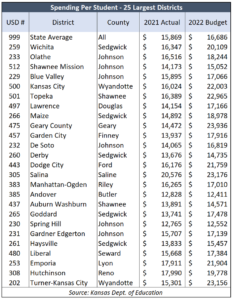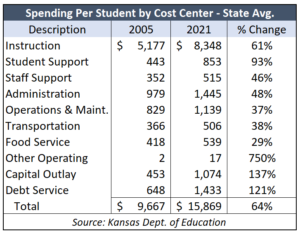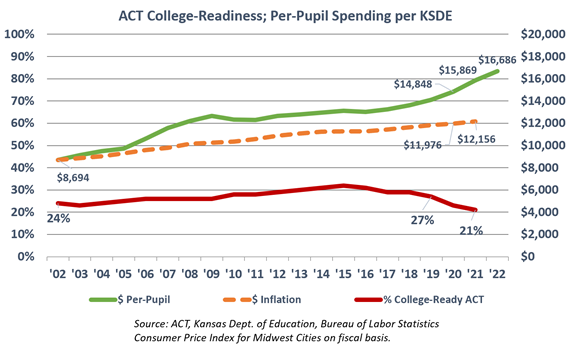Data published by the Kansas Department of Education show school budgets average $16,686 per student this year. Actual spending for the 2021 school year was $15,869.
A review of the 25 largest districts based on enrollment shows budgeted spending ranging from a low of around $12,000 for Andover to  almost $24,000 for Geary County Schools. Andover has considerable enrollment in their virtual learning program, and funding for those students is much. Spring Hill is another district with a large virtual learning program.
almost $24,000 for Geary County Schools. Andover has considerable enrollment in their virtual learning program, and funding for those students is much. Spring Hill is another district with a large virtual learning program.
Geary County is joined by seven other districts with budgets exceeding $20,000 per student – Wichita, Kansas City, Topeka, Dodge City, Salina, Emporia, and Turner KC. But this is just among the 25 largest districts; there are likely many more budgeting more than $20,000 per student. Last year, 52 districts spent more than $20,000 per student.
Extra federal funding is driving some of the budget increases, but schools are also receiving $275 million more in state funding this year. Total funding is budgeted to be $7.8 billion and Gov. Kelly wants to give them another gift of $200 million that isn’t reflected in their budgets.
Details on each district’s actual spending for FY 2021 can be found here and their budget reports are here.
Spending on Instruction, other cost centers
Spending is allocated across 10 cost centers – Instruction, Student Support, Staff Support, Administration, Operations & Maintenance, Transportation, Food Service, Other Operating, Capital Outlay, and Debt Service.
Total spending per student increased twice as fast as inflation since 2005 (64% vs. 32%). As shown on the adjacent table, Capital Outlay and  Debt Service recorded the largest increases, and only Food Service spending grew below the inflation rate.
Debt Service recorded the largest increases, and only Food Service spending grew below the inflation rate.
The Department of Education accounting guidelines allow some capital spending to be allocated as operating costs, but this analysis doesn’t do that because capital outlay often fluctuates a great deal from one year to another. Spending by cost center for each district can also be found in district snapshots on KansasOpenGov.org, which also compare changes in funding, employment, cash reserves, and enrollment.
KansasOpenGov also has reports that track annual changes in cash reserves, employment & enrollment, and funding per student.
Budgets rise but achievement keeps falling with academics de-emphasized
These large spending increases have not led to better outcomes as school officials and the Kansas Supreme Court predicted, and they don’t want to talk about the shift away from academic preparation.
The percentage of graduates considered college-ready in English, Reading, Math, and Science on the ACT exam fell to just 21% last year. Education officials blame the recent decline on COVID and having more students taking the ACT. However, some states recorded gains in 2021 despite COVID and the decline in Kansas predates the rise in students taking the ACT.

Predictably, education officials blame achievement declines that began in 2015 on funding. They say it just didn’t grow enough overall and some of the growth was not in base state aid, but that excuse also doesn’t hold up. Schools could have allocated more money to Instruction if they wanted and they also could have drawn down some of the enormous cash reserves they held (most of which represents aid provided in prior years but not spent). The Department of Education ignores the fact that its Kansans Can initiative, which de-emphasized academic achievement and accountability and pushed much harder on social emotional learning (SEL). Diversity, equity, and inclusion (DEI), which emphasizes gender issues and teaches kids that all white students are racists who suppress students of color, now also seems to be the dominant focus of many schools.





